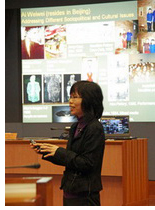 The development of Contemporary Chinese Art is increasingly gaining attention from the western world. Dr Silvia Fok of PolyU’s General Education Centre has written two research publications concerning Contemporary Chinese Art. In this issue, she will share her findings in the evolution of Contemporary Chinese Art. The development of Contemporary Chinese Art is increasingly gaining attention from the western world. Dr Silvia Fok of PolyU’s General Education Centre has written two research publications concerning Contemporary Chinese Art. In this issue, she will share her findings in the evolution of Contemporary Chinese Art.
Q1: What are the major differences between Contemporary Chinese Art and Contemporary Western Art?
Contemporary Chinese Art is relatively short in history compared to that of the West. It is more culturally specific such that the majority of the artworks draw references either from Chinese culture and traditions, or the socialist legacies.
Q2: Please briefly introduce two of your research publications concerning Contemporary Chinese Art
- The Stars Artists: Pioneers of Contemporary Chinese Art
- Performance Art in China: Site and the Body
 A: The Stars Artists: Pioneers of Contemporary Chinese Art 1979-2000 (2007) examines how the “Stars Exhibition” (1979-80) stood out among the other unofficial art exhibitions and the radical role the “Stars” artists played in fighting for new forms of exhibition in the late 1970s. It also reveals the diversity of artworks displayed in the “Stars Exhibition” (1979-80) and discusses the artistic development of twelve “Stars” artists after the group disbanded in the early 1980s. A: The Stars Artists: Pioneers of Contemporary Chinese Art 1979-2000 (2007) examines how the “Stars Exhibition” (1979-80) stood out among the other unofficial art exhibitions and the radical role the “Stars” artists played in fighting for new forms of exhibition in the late 1970s. It also reveals the diversity of artworks displayed in the “Stars Exhibition” (1979-80) and discusses the artistic development of twelve “Stars” artists after the group disbanded in the early 1980s.
 Performance Art in China: Site and the Body (2010) interprets and evaluates Chinese performance art by highlighting the site-body relationship. It juxtaposes and compares works addressing similar issues of different times, or works with similar visual representations addressing different issues of different times. Performance Art in China: Site and the Body (2010) interprets and evaluates Chinese performance art by highlighting the site-body relationship. It juxtaposes and compares works addressing similar issues of different times, or works with similar visual representations addressing different issues of different times.
Q3: Contemporary Chinese Art is gaining attention from the western world. What are the reasons besides the fact that the modern Chinese art pieces have made record prices on international and domestic art auction markets?
Chinese artists have been invited to take part in international exhibitions and biennials since 1993. There are multiple platforms for them to get exposure in the West, through exhibitions, artist-in-residence programmes, and other art exchange activities. The success of some renowned Chinese artists also helps to arouse Western interest in the large number of artworks produced by contemporary Chinese artists. Recent research and publications on Contemporary Chinese art by Western and Chinese scholars alike further help to enhance Western understanding of Contemporary Chinese art.
Q4: Some people said that Contemporary Chinese art has changed the Contemporary Asian art world. What are your views?
The art fairs held in Asia and the West have helped to facilitate the development of Contemporary Asian art market. Although the Contemporary Asian art market seems to be dominated by key Contemporary Chinese artists like Zhang Xiaogang, Wang Guangyi and Yue Minjun, it is also noticeable that there is a growing interest in artworks produced by artists from the South East Asia (Thailand, Vietnam and Cambodia). The extent to which Contemporary Chinese art has changed the Contemporary Asian art world deserves more research.
Q5: Please share your views on the future development of the Contemporary Chinese Art scene?
The blooming of Contemporary Chinese Art in the past two decades has undeniably pathed the way for emerging artists to explore more actively the new directions in making art. Whether they could transcend their predecessors, make breakthrough and draw attention remains a question.
|